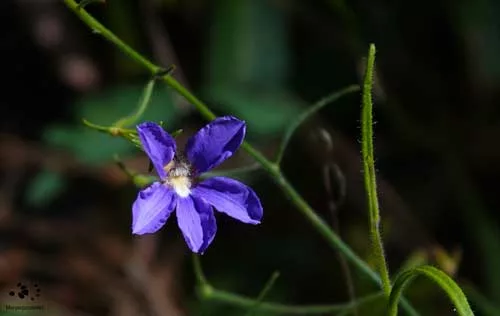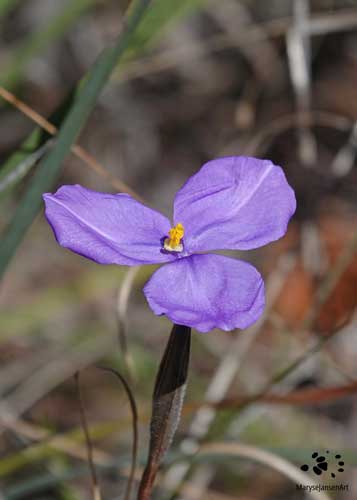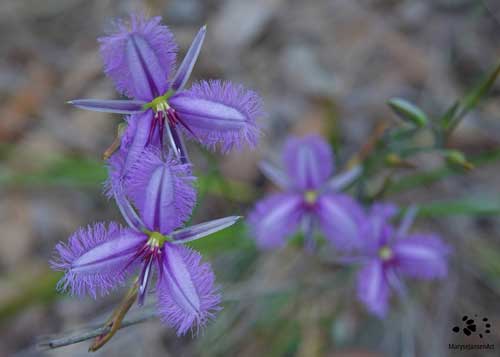Wildflower Photography with marysejansenart
Purple Wildflowers Provide Royal Beauty to the Forest

Table of Contents
Purple Wildflowers in the Forest
The forest is dark and damp, even though the sun is shining brightly in a blue sky above the canopy. The harsh sunlight penetrates the forest occasionally with a few thin rays, which increases the contrast with the darkness below. I smell the earthy scent of the dirt under my feet, mixed with that of a variety of plants and flowers. I hear a number of different bird sounds and every now and then I get a glimpse of one of them through the thick vegetation. One of the sun rays reaches ground level and illuminates a beautiful purple wildflower!
There is something special about a purple flower in nature. One reason could be that there are not so many purple flowers around compared to colours like yellow, red and white. The feeling of finding something that is quite rare induces a level of awe.
But there is something about the colour itself as well. Being a mix of blue and red, the colour purple can have both a relaxing and a stimulating effect on us. Consequently it is often associated with insight, creativity, wisdom and spirituality. In many cultures it is regarded as a royal colour!
Hairy Fan Flower
This purple flower on the forest floor certainly radiates a sense of royalty! And the little bit of sunlight that illuminates it really brings out the colour perfectly! This flower is called the Hairy Fan Flower (Scaevola ramosissima), and is also known as the Snake Flower. It is a sprawling herb that grows in rocky areas or on sandy soils in Sclerophyll Forests. It is native to south-eastern Australia.

Flowering occurs in spring and summer. The five petals of the 3.5cm big flowers are fan-shaped. The throat is white and bearded with stiff hairs. The stems as well as the long, thin leaves are hairy too. The plant belongs to the Goodeniaceae family. In an earlier post I talked about the Broad-leaved Goodenia which is a yellow flower from the same family.
I leave the Hairy Fan Flower behind and walk on, pondering on memories of purple wildflowers I have encountered during earlier walks.
Silky Purple Flag
I remember a walk in a coastal forest, in the Great Sandy National Park, it was spring and there were lots of wildflowers around. The majority of them was white or a cheerful yellow. And then there were the beautiful purple flowers of the Silky Purple Flag (Patersonia sericea), also known as the Hairy Native Iris! So intense was the colour in the bright spring sun, that it immediately caught my attention! The perfect counterpart to the surrounding greens, browns, whites and yellows. It seemed to bring the whole colour palette in balance!

This plant belongs to the family of Iridaceae. It is a strap-leaf perennial herb, growing up to 50cm tall. Multiple stems with one flower each, appear from the tufted, grassy-like looking plant. It is native to eastern Australia and prefers sandy soils. It can be seen in forest, heathland and open woodland. It flowers from winter to spring with 3-petalled purple flowers, sized up to 30mm.
Fringed Lily
I also remember another walk in spring, through a Eucalyptus Forest. There I spotted one of my favourite flowers: the Fringed Lily (Thysanotus Tuberosus)! It is also known as the Common Fringe-lily

This plant is also a perennial herb, growing 20-60cm tall. It flowers from September through to April. The flowers have 3 petals with frills on the edge. Normally the flowers are purple, but they can also be white or blue. Each branched stem may contain up to eight flowers. The plant is native to Australia and is mainly seen in south-eastern Australia, but it also spreads up the east coast when conditions are right. It can be seen in dry-sclerophyll forest, heathland and open woodland.
The Fringed Lily belongs to the family of Asparagaceae and, interestingly, to the subfamily of Lomandroideae! In this same subfamily we also find the Lomandra longifolia, about which you can read in an earlier post! It’s a small world!
Join me on my latest walk through an inland rainforest and spot the perfectly purple Hairy Fan Flower on the forest floor:
If you are interested in purchasing a print of ‘Perfectly Purple’ or would like to see what the image looks like on the various merchandise products, please head to my shop. If you’d prefer ‘Silky Purple Flag’, click shop here and for ‘Fringed Lily’, click shop here.


